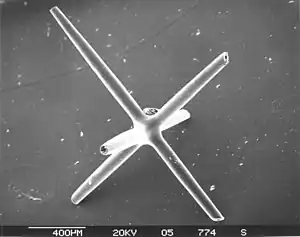Siliceous sponge
The siliceous sponges form a major group of the phylum Porifera, consisting of classes Demospongiae and Hexactinellida. They are characterized by spicules made out of silicon dioxide, unlike calcareous sponges.
| Siliceous sponges | |
|---|---|
 | |
| Hexactinellid spicule | |
| Scientific classification | |
| Domain: | Eukaryota |
| Kingdom: | Animalia |
| Phylum: | Porifera |
| Clade: | Silicispongia Schmidt, 1862 |
| Classes | |
Individual siliachoates (silica skeleton scaffolding) can be arranged tightly within the sponginocyte or crosshatched and fused together. Siliceous spicules come in two sizes called megascleres and microscleres.
Systematics
Most studies support the monophyly of siliceous sponges.[1]
The group, as a part of the phylum Porifera, has been named Silicispongia Schmidt, 1862 and Silicea Bowerbank, 1864.[2] Silicarea is a proposed new phylum based on molecular studies of the phylum Porifera. It consists of the Poriferan classes Demospongiae and Hexactinellida. Some scientists believe that Porifera is polyphyletic/paraphyletic, and that some sponges, the Calcarea, are a separate phylum which was the first to diverge from the main line of kingdom Animalia. Silicarea is considered the next phylum to diverge from the primary animal lineage.
Ecology
Siliceous sponges are usually found in the marine ecosystem but they are occasionally found in freshwater.
During the Triassic, siliceous sponges grew reefs similar to calcarea of the modern era. During the Cretaceous period, diatoms became so successful that they significantly decreased the amount of silica present in sea water, after which "siliceous sponges could never again form reefs."[3]
References
- Mónica Medina, Allen G. Collins, Jeffrey D. Silberman & Mitchell L. Sogin (August 14, 2001). "Evaluating hypotheses of basal animal phylogeny using complete sequences of large and small subunit rRNA". Proceedings of the National Academy of Sciences of the United States of America. 98 (17): 9707–9712. Bibcode:2001PNAS...98.9707M. doi:10.1073/pnas.171316998. PMC 55517. PMID 11504944.
{{cite journal}}: CS1 maint: multiple names: authors list (link) - Adl; et al. (2005). "The New Higher Level Classification of Eukaryots with Emphasis on the Taxonomy of Protists" (PDF). Journal of Eukaryotic Microbiology. 52 (5): 399–451. doi:10.1111/j.1550-7408.2005.00053.x. PMID 16248873. S2CID 8060916.
- Stanley, Steven; Luczaj, John (2015). Earth System History (4th ed.). WH Freeman and Company. p. 424. ISBN 978-1-4292-5526-4.